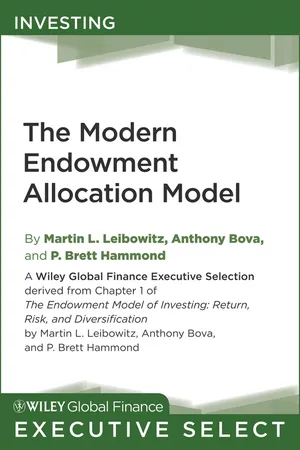![]()
Part One
Alpha/Beta Building Blocks of Portfolio Management
![]()
CHAPTER 1
The Modern Endowment Allocation Model
Over the past two decades, many institutional investors, beginning with the larger ones, adopted a broadly diversified asset allocation with greatly reduced allocations of traditional U.S. equities and bonds. Endowments and foundations, in particular, adopted this allocation model.
TRULY LONG-TERM ORIENTATION
The traditional and widely used institutional asset allocation benchmark or policy portfolio commonly consisted of a majority of U.S. equities and a reciprocal proportion of U.S. bonds. Beginning in the 1990s, endowments increasingly took advantage of the nature of their liabilities to adopt a purposeful diversification directed toward long term outcomes and a much-reduced focus on the short term.
NOVEL ASSET CLASSES AND SPECIAL ACCESS
This (re)evolution was largely driven by a growing awareness of investable assets containing return premia derived from such nontraditional features as illiquidity, longer investment horizons, less-than-transparent valuation, and other factors. Leading endowments turned to nonstandard alternative assets and to managers with niche expertise, special flexibility, and unique market access. As shown in Exhibit 1.1, between 1992 and 2008, college and university endowment allocations to nonstandard assets—real estate, hedge funds, private equity, natural resources, venture capital, and other alternatives—rose from 3 percent to more than 25 percent, with a commensurate decrease in allocations to fixed income, cash, and public U.S. equity (National Endowment Surveys, hereafter NES).1
Dramatically, by the end of this period, the largest endowments and foundations—those over $1 billion in assets—had increased their commitment to nonstandard assets, on average, to 50 percent of the total portfolio.
REMAKING THE INVESTMENT MANAGER RELATIONSHIP
Endowments and foundations have traditionally depended on a successful selection of internal and external investment managers. The growing commitment to alternative assets as opposed to traditional assets has required a reworking of many of these processes, including far more intensive manager screening, vetting, and monitoring; significantly increased sensitivity to alignment of interests between the institution and its managers; and the need to incubate and nurture special investment talent (internally as well as externally). Specific mechanisms include direct support for investment startups and spinoffs, selected acceptance of lockups and performance fees, claw-backs, and a regular intensive analysis of manager performance and risk.
MORE MARKET-SENSITIVE ALLOCATIONS
The tradition of the long term policy portfolio with relatively fixed asset categories was at one point ubiquitous in the endowment and foundation world. The strategic policy portfolios and accompanying asset class buckets were intended to act as benchmarks against which actual allocations could be gauged. This system promoted rigid allocations, regular rebalancing, and adherence to the underlying asset buckets. However, increased market volatility and the appearance of attractive new asset classes called into question this tradition of overly rigid allocations and fixed asset buckets. Institutions were urged to work in a more flexible fashion with allocations (for example, establish wider allocation bands and more frequent policy portfolio reviews) and to use assets that did not necessarily fit into the traditional categories (Bernstein 2003; Leibowitz and Hammond 2004). The late Peter L. Bernstein was one of the earliest and most articulate authors arguing for a rethinking of the policy portfolio conc...

